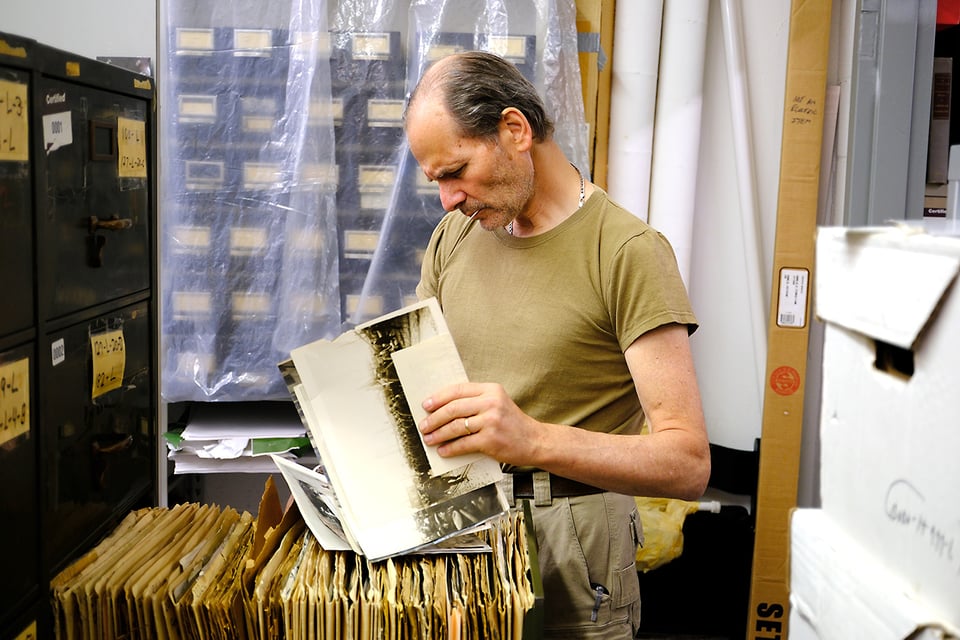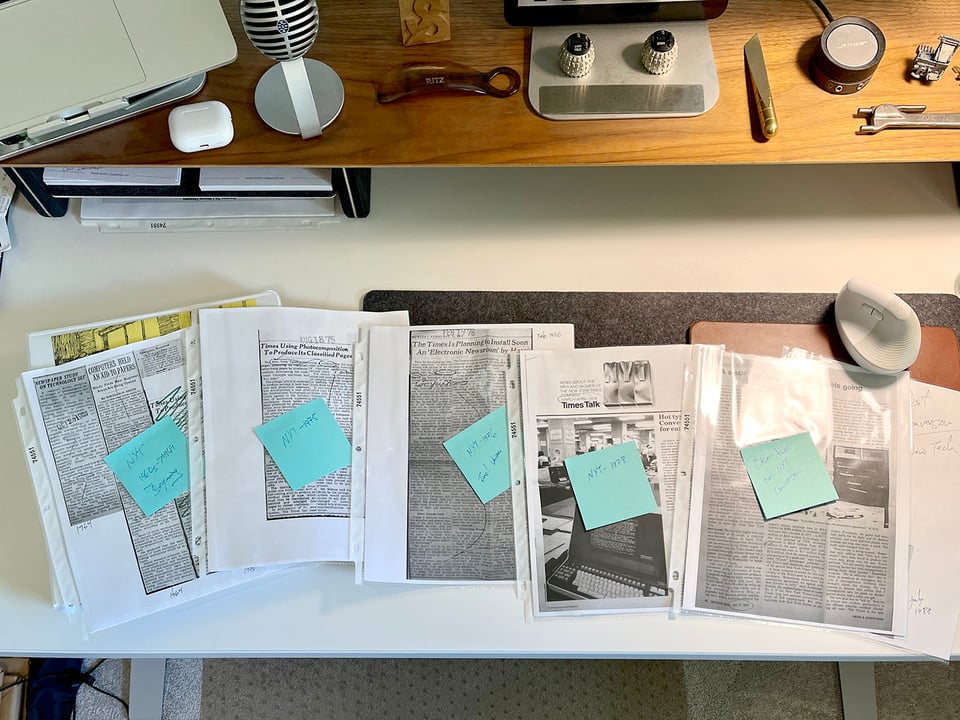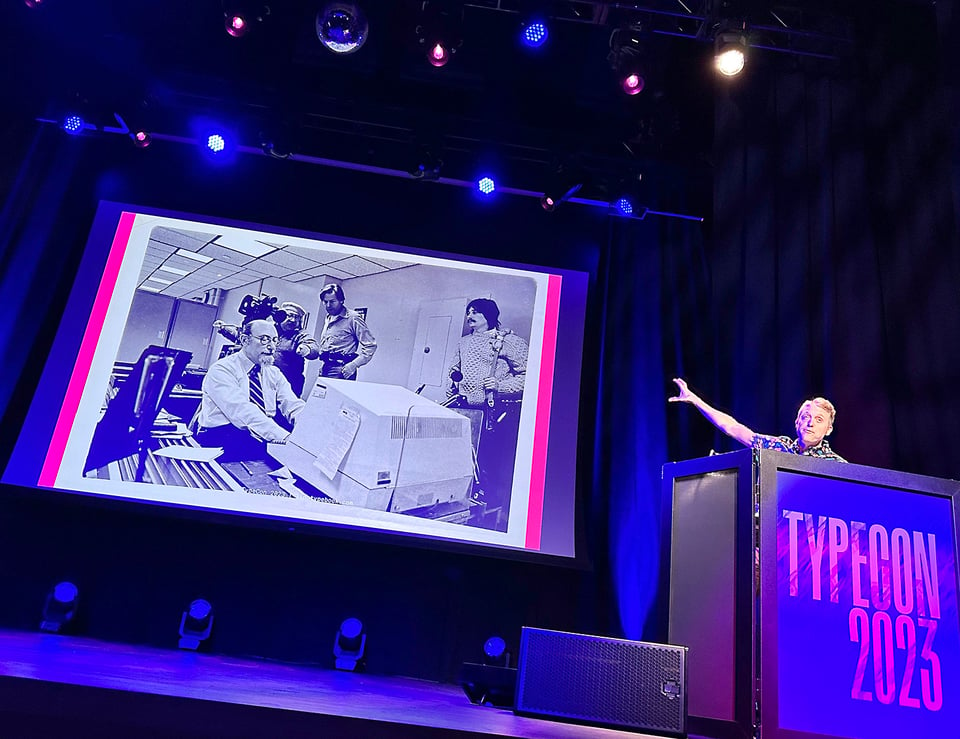LBP - Issue № 5 - Digging Through a Morgue
Follow along as I dig through the “New York Times” morgue, uncovering treasures from the transition to computer phototypesetting in the 1970s.

Linotype Book Project - Issue № 5
Digging Through a Morgue
But First, a Confession
I have a confession to make: When I wrote about my research trip to NYC back in June (Issue № 3), I kept something from you, my dear subscribers. I only briefly mentioned that I visited the clippings archive of The New York Times and then quickly shared about all the other wonderful aspects of my visit instead.
I wasn’t trying to hide things, I just had so much good stuff to share from the trip already. So, it’s time to come clean and tell you all about my magical half-day digging through the NYT morgue and all of the goodies I uncovered.

Don’t Call it an “Archive”
I met Jeff Roth at the shiny, 8th Avenue NYT building on the morning I was set to fly back home. After being connected with Jeff by design author Steven Heller, it was nice to meet him in person. Jeff has been working at the morgue since the 1990s and he is the last remaining employee working with the materials.
After a very short visit to the “museum room” on the 15th floor, we headed back down the elevators to the ground floor and out the front doors of the building. You see, the morgue isn’t in the fancy, new building—it is a short walk away in the basement of the former New York Herald Tribune, a couple stories underground and accessed through a door in the back of a loading dock.

Walking with Jeff, he seems to know every person on the street and they all yell “Hey!” to him, while giving me the side-eye. When we stop to chat with someone, I try to slyly snap a photo, and the other person asks “You know this guy, Jeff?” in the most NYC accent you’ve ever heard. Jeff vouches for me and we go on our way, down a couple floors, finding two unmarked metal doors, and Jeff puts his key into the lock.
“Don’t call it the archive,” Jeff says, “this is just the clipping and photo library.” He insists the “archive” is the corporate materials related to the company which are held at the NYPL. The morgue contains literally an unknown number of newspaper clippings, 5–7 million photographs, and just about everything else you could imagine. Organized by subject matter, person, or historical event, this was once the resource reporters would utilize to get background information and context for an upcoming story or a late-breaking news item.

What Do You Want to See?
Once Jeff opens the doors and switches on the lights, I’m overwhelmed by the number of stacked filing cabinets, storage drawers, and NYT memorabilia on practically every surface. For those of you who are as nerdy as me, check out this short video on the morgue or this article about moving the morgue in 2007. And before you ask: no, the contents of the morgue aren’t digitized…
“Well, what do you want to see?” Jeff asks as he puts a jazz album in the CD player. “I pulled some clippings related to the transition to computers at The Times.” And that’s why I’m here: to investigate the transition from hot metal composition to computer phototypesetting in the 1970s.

The Times was one of the last major newspapers to make this transition on July 3, 1978. Most other papers got rid of their Linotypes in the 1950s and ’60s, so why were they so late? As I’ve been learning, the answer gets down to labor unions, fast-changing technology, and good old American capitalism.
Jeff gives me the files he pulled and said, “Well, I have some other things to do, so I’ll be back in a while.” And with that, I’m as giddy as a schoolboy left alone in a candy shop. I take a deep breath and start unpacking manila folders, sorting old black and white photographs, and unfolding columns of newspapers and magazines.
“Farewell, etaoin shrdlu” and So Much More
My fascination with this transition at The Times can be traced back to the wonderful film Carl Schlesinger and David Loeb Weiss made documenting the last day of hot type in 1978. “Farewell, etaoin shrdlu” was a great resource for our film, but also kept bringing up more questions than we could answer in the film.

I’m interested in the multiple story lines that went into this technological change and my goal is to write the definitive story of how it happened in my book.
- When did the idea to change to cheaper forms of composition start?
- Did the whole paper change at once?
- How long did the “NY Big 6” typesetting union fight the change and how ruthless were the negotiations?
- What happened to all of the Linotype operators?
- What are those goofy-looking computers we see in the film?

Times Talk & Photos
I uncovered many things on my short visit to the morgue. For one, The Times had an internal publication called Times Talk that documented life and happenings inside the organization. Especially helpful were the issues with articles about the upcoming transition to cold type and how it would affect every part of the newspaper.
I also discovered some amazing photos of the typesetting room, stereotype room, and even a photo of Carl and David making their film back in 1978! I could have spent a week just staring at all the photos and their typewritten captions on the back, they were all so amazing.

Into the Sunshine and Into My Computer
After two hours of digging through the clippings and photographing every article I could find, Jeff came back and asked, “Well, did you see everything you wanted?” I don’t recall my response, but I’m sure it was along the lines of, “I guess? I’m pretty sure I could stay here for a year and still find new things…”
And with that, we walked back up to ground level, out into the sunshine, and said our goodbyes. Jeff went one way and I headed to the subway and onward to the airport—my head still spinning from what I had just experienced. I called my friend (and film partner) Jess on my walk to practically yell about how I just got to dig through the morgue at The Gray Lady because I knew he would understand how amazing it was.
A Peek into My Process
Whew—this update has gotten long. If you’ve made it this far, you are a true fan and may be interested in my process for research. Due to the time constraints, I take pictures of all the materials I view at the various locations. Back at the hotel or at home, I organize the photos on my computer; cropping and arranging the articles in Photoshop.

I’m a little embarrassed to say, but I can’t read or edit documents on a screen easily, so I print them out and file them in a 3-ring binder of articles I’ve collected. Next, I read through these articles, highlight important facts and stories, and add notes to my spreadsheet which tracks all of the various books, articles, and films that will inform the final book.

As summer winds down, I am so incredibly excited about my research so far. I’m proud of the locations visited and the new threads I’ve uncovered. Throughout this process, I’ve been encouraged by your support and interest in this zany process, so as always—thank you for subscribing.
That’s it for now,
Doug